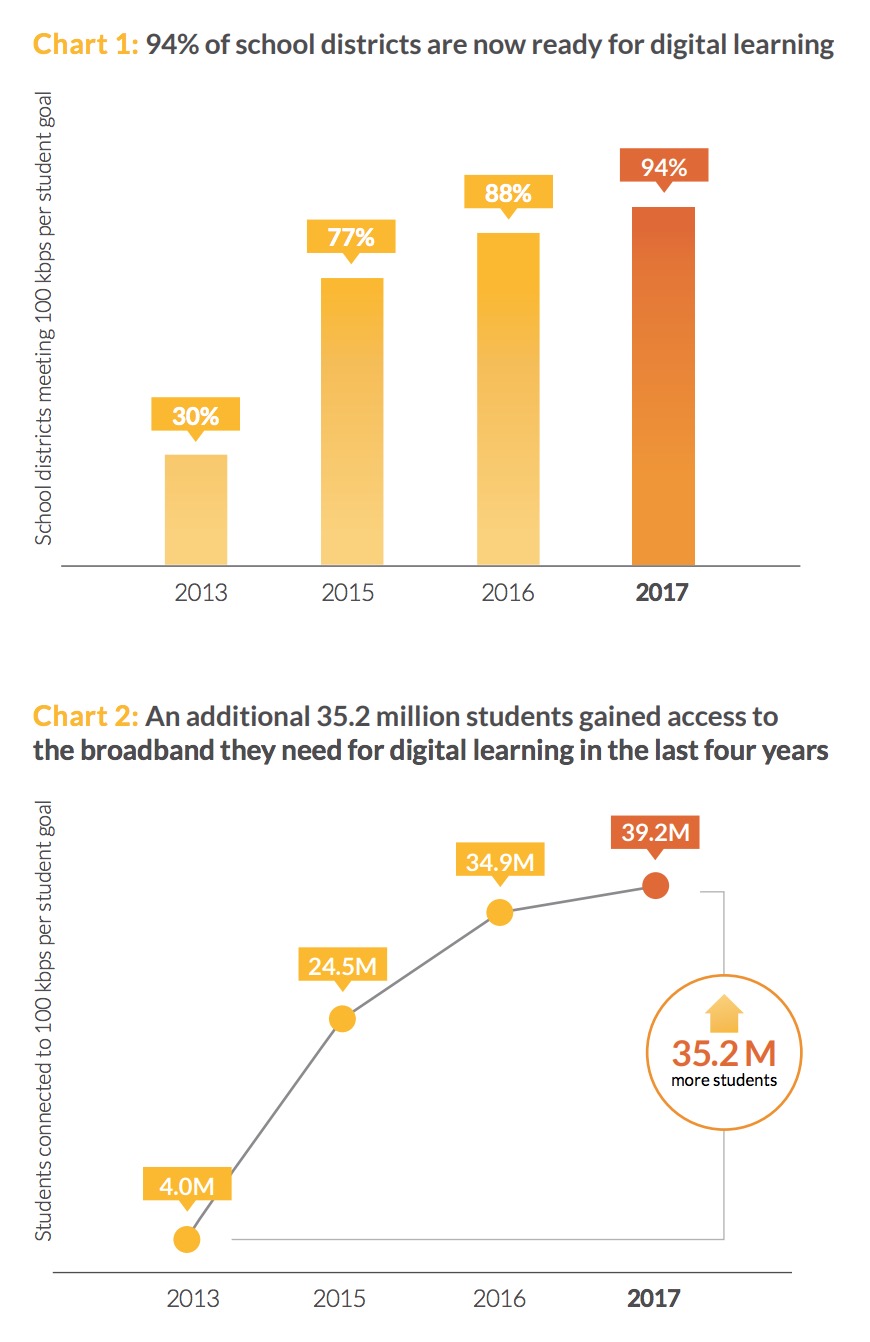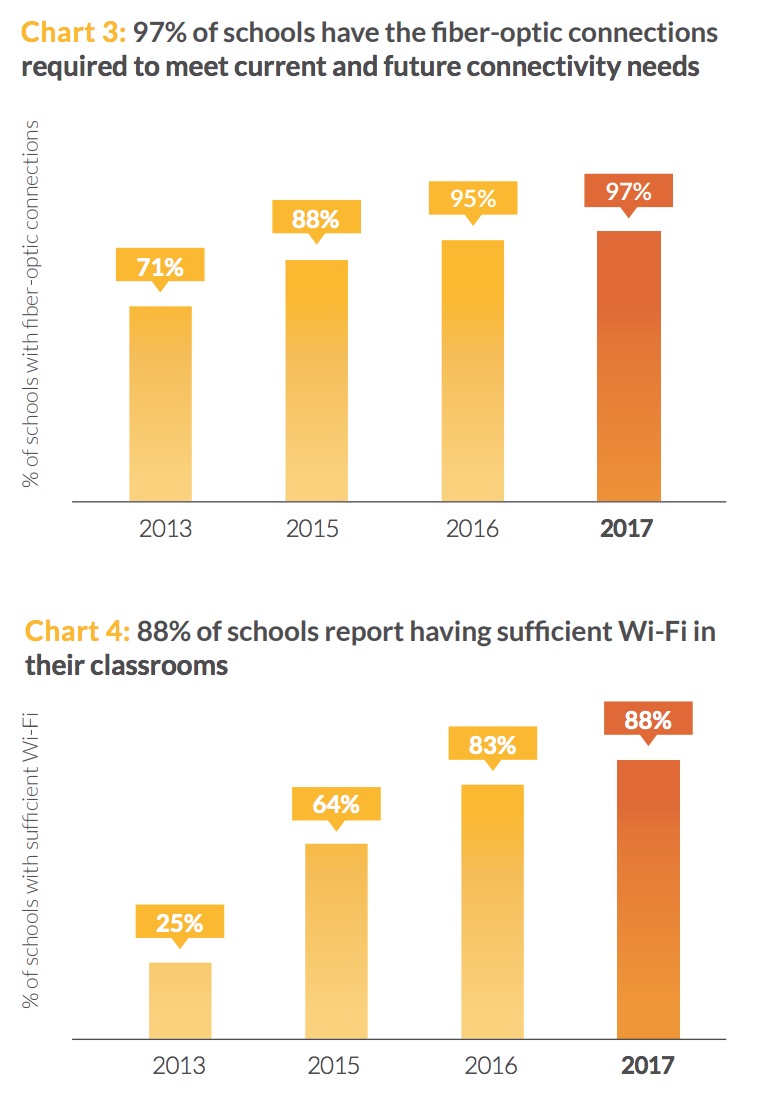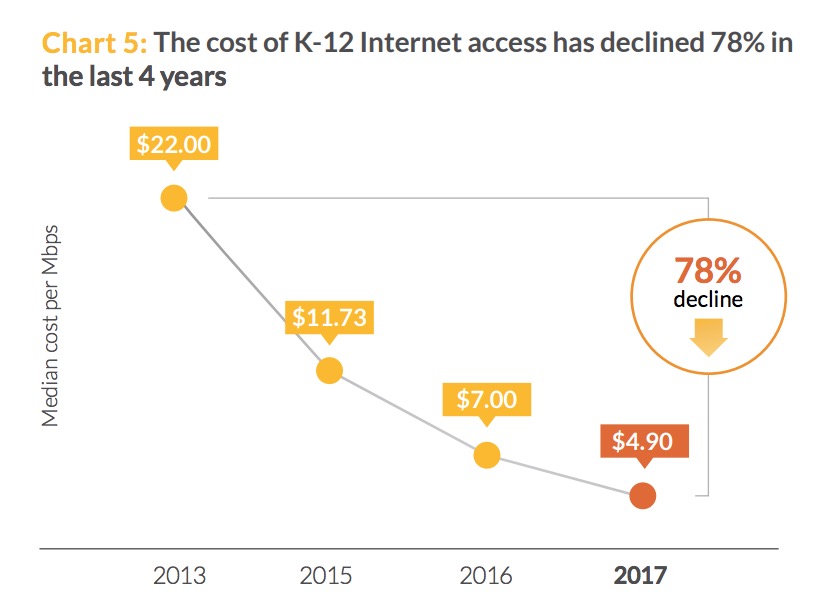EDUCATION SUPERHIGHWAY
Broadband in Schools: 2017 State of the States
National highlights: 6.5 million students left to go
In 2013, our nation made a promise to close the K-12 digital divide and level the playing field for children throughout America. In the past four years, unparalleled bipartisan action has led to exceptional progress toward fulfilling this promise by connecting an additional 35.2 million of our students. This progress has been possible thanks to the joint efforts of many, including:
- The Federal Communications Commission (FCC), which modernized the E-rate program.
- 46 governors, who have led the effort to upgrade their states’ school broadband networks.
- State and school district leaders, who have brought high-speed connectivity to 8,379 school districts.
- Service providers, who have dramatically improved the affordability of broadband.
In 2017, the progress made possible by E-rate modernization continued, reducing the number of students without high-speed Internet access by 5.1 million and the number of schools without 21st-century broadband infrastructure by 45%, thereby setting the stage for the nation to deliver on our promise of digital equity by 2020.
Our Nation’s Connectivity Promise
In 2014, the Federal Communications Commission (FCC) modernized the E-rate program. That was the first step in delivering on our nation’s promise to connect America’s public school students. The FCC established three connectivity goals:
1. 100 kbps per student of Internet access, the minimum recommended bandwidth to enable digital learning in the classroom.
2. Fiber connections to every school, so that school bandwidth can reliably grow over time.
3. Wi-Fi in every classroom to support one-device-per- student programs.
39.2 million students and 2.6 million teachers in 74,000 schools now have the Internet access they need for digital learning.
Since 2013, the bipartisan effort to connect America’s students to 21st-century learning has delivered high-speed broadband to 94% of public school districts, representing an increase of 35.2 million students and 2.3 million teachers who are now meeting the FCC’s minimum Internet access goal of 100 kbps per student.
To date, nine states have achieved the remarkable milestone of delivering high-speed Internet access to 100% of their students. This dramatic improvement in connectivity has leveled the playing field for students regardless of their level of affluence or location, and it is propelling forward digital learning opportunities across the country.
We also dramatically improved the infrastructure needed to deliver high-speed broadband to classrooms.
To deliver high-speed broadband to students and teachers, every school needs a fiber-optic connection and every classroom needs a Wi-Fi access point. Today, estimates show that 97% of schools are connected by fiber and 88% of schools report having sufficient Wi-Fi in their classrooms.
Service providers have made broadband significantly more affordable.
In 2017, Internet service providers continued to dramatically increase the affordability of broadband by taking advantage of technological improvements that allowed them to provide significantly more bandwidth to school districts at the same cost. As a result, the cost of Internet access declined 30% from 2016 to 2017.
What’s Left to Do
We’ve made dramatic progress, but to deliver on our promise there is more work to be done.
There are still:
- 6.5 million students who don’t have affordable Internet access, limiting their ability to adequately prepare for college and careers.
- 2,049 schools that don’t have fiber infrastructure, limiting their ability to engage in current and future digital learning opportunities.
- 10,000 schools that don’t have sufficient Wi-Fi, limiting teachers’ ability to deliver personalized learning for every student.
While we must continue to expand the bandwidth available to the 39.2 million students in America’s connected classrooms in order to meet growing demand from increased technology use, our immediate task is to work through the challenges the remaining students and schools without sufficient connectivity are facing.
What follows in this report is an analysis and path forward for addressing each of these challenges so we can keep our promise to America’s students and close the K-12 connectivity gap by 2020.
Download full version (PDF): Fulfilling Our Promise to America’s Students
About EducationSuperHighway
www.educationsuperhighway.org
EducationSuperHighway is the leading nonprofit focused on upgrading the Internet access in every public school classroom in America. We believe that digital learning has the potential to provide all students with equal access to educational opportunity and that every school requires high-speed broadband to make that opportunity a reality.
Tags: E-rate modernization, Education Superhighway, EducationSuperhighway, K-12, schools









 RSS Feed
RSS Feed